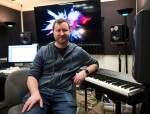When a tree falls in a movie, and the audience needs to hear it, a dedicated team of experts is there to ensure that it makes a sound.
Creating audio for film and television will be the focus of an event hosted by Creative Labs, a club that designs creative, real-life projects with the aim of bringing together students from all areas of study. The talk, which is set to take place at the Northwest Campus Auditorium on Tuesday, will feature Oscar-nominated sound editor Erik Aadahl as its main speaker. Along with fellow sound editor Ethan Van der Ryn, Aadahl founded the award-winning sound design company E Squared, which has worked on films such as “A Quiet Place” and “Argo.” Aadahl said he plans to draw on his experience with E Squared at the event by discussing the multistep process of creating sounds for films.
“The most common definition (of a sound designer) is somebody who’s creating sound from scratch, tailor-made for a specific film and a specific story. … It can be a really abstract art where you use something you’d never think of for something on screen,” Aadahl said. “The challenge is making that work and finding that alchemy between sound and picture.”
On set, the only sounds typically recorded are dialogue – additional noises are constructed by sound designers in postproduction, Aadahl said. Footsteps, the vocals of a robot and ambient jungle noises are all sounds Aadahl has been responsible for producing in films he’s worked on.
Aadahl said he plans to talk about using innovative techniques to create sound, using an example from his work with “Kung Fu Panda,” in which he used a 100-foot bungee cord and a spatula to produce the noise of two characters’ movements during a chopstick battle scene.
Sound designers often go out and collect sounds like dripping water or racing cars, but they can also create sounds in a studio using unlikely objects. While working on “A Quiet Place,” for instance, Aadahl had to design the sound of the blind monsters, which rely on their keen sense of sound to track people down and attack them. He went about the process by pressing a stun gun to a bunch of grapes and slowing the speed of the recording to resemble the clicks of echolocation.
“In experiencing cinema you’re using two senses, vision and hearing, and I feel strongly that sound is half of the experience,” Aadahl said. “For me, my starting point is like, ‘What’s the story? What’s the script? How can sound tell that story?'”
Sound has to follow the relationships and context of the movie, Aadahl said. For example, in “A Quiet Place,” the audio must reinforce the logic of a family that has adapted to understand how sound functions – which noises are too loud and where they are more likely to be heard, he said. Aadahl compares the role of sound to that of a character in “A Quiet Place” – it drives the narrative and acts as such a pivotal plot point to the extent that it seems to take on a life of its own.
Eric Marin, a lecturer in the UCLA School of Theater, Film and Television, teaches a class on digital audio postproduction and views sound not just as a way to replicate reality, but as a means to convey who characters are. By putting an audience into the same space as characters, sound can help viewers identify with them, he said. Marin gave the example of a scene from the film “50/50” in which the protagonist learns of his cancer diagnosis. In this scene, his doctor’s chattering voice fades out, putting the audience into the mindset of the character who is trying to process the news.
“I think what sound will do is it triggers your imagination, and it can transport you to a time and a place even without the visuals,” Marin said.
Sonia Xavier, a fourth-year cognitive science student and the business sponsorship and partnership director for Creative Labs, said the event suits the organization’s purpose. Creative Labs aims to encourage students to pursue their creative interests, Xavier said, even if they lack technical experience. She also said Creative Labs tries to host events which promote the theme that creative career paths are tangible for all students.
Even to students who aren’t pursuing a related career path, sound is such a crucial part of the cinematic and human experience that learning about sound design can be beneficial, Marin said.
“I think going to hear a lecture about sound might actually make somebody more aware of how sound is getting to us and how we’re hearing it and how it’s being actually digitized, … how that process is happening,” Marin said.
Aadahl said the event is meant to be fun rather than technical and will feature clips and sound demos from movies he has worked on. The event will also feature a Q&A portion in which Aadahl will open up the talk to audience questions. Aadahl said the event will cover the basics of sound design from conception to completion.
“Mostly I just want to talk about the process and the art of sound design. … It’s a very misunderstood art, but I think a super interesting one,” Aadahl said. “Sound is so part of us that we don’t really realize how truly powerful it is.”
